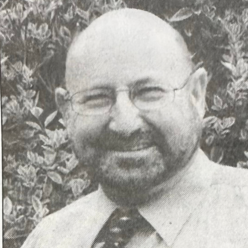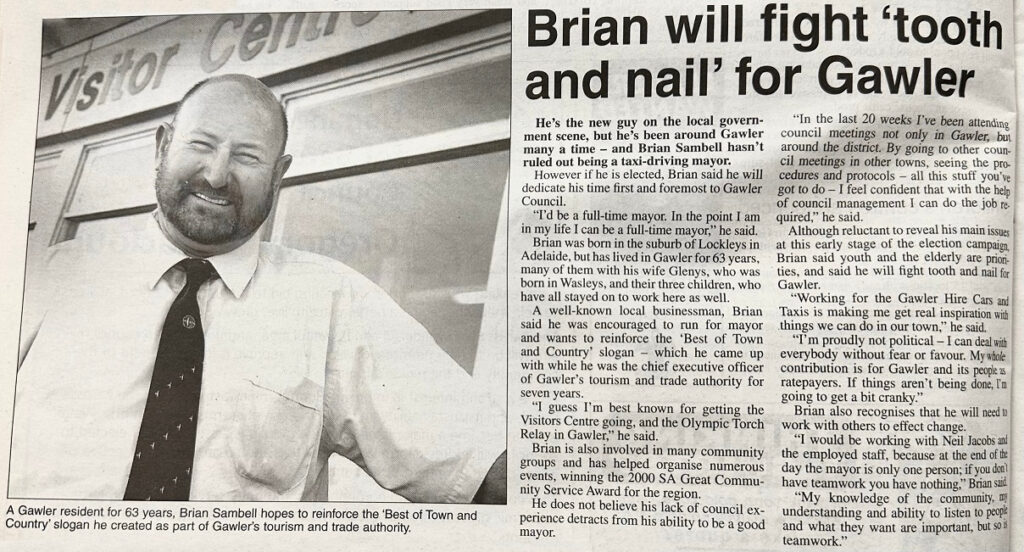The November 2006 Gawler Council elections had a lot going on, but there is one particularly unusual aspect of the last Council term we need to address before we can go any further.
That is, Mayor Tony Piccolo resigned six months before the election and a new Mayor took his place for the remainder of the term.
The Resignation of Tony Piccolo

The Bunyip, March 22nd, 2006.
Tony Piccolo, who had been the Mayor since the May 2000 Council elections, resigned in March of 2006 due to his election as the local Member of Parliament.
Currently, someone can’t hold a state and local-level elected position simultaneously. Thus, a Councillor or Mayor who wins an election to Parliament must resign from their position in local government. That said, this was not always the case; as late as 1993, Dr Bruce Eastick had served as both the Mayor of Gawler and Member for Light at the same time.
Since that time, however, the rules had changed. Tony Piccolo vacated the position of Mayor, and the remaining Gawler Councillors met to internally elect a new leader to carry through from March to the Council election in November. The unopposed winner was Deputy Mayor Helena Dawkins.

The Bunyip, April 5th, 2006.
Helena Dawkins became the first woman to have ever been elected Mayor of Gawler. This was not a surprising choice for the Councillors to make; Dawkins had been Deputy Mayor for five of her six years on Council.
The next question was whether she could follow through to become the first woman to be publicly elected as Mayor of Gawler, which would depend on the results of the upcoming election.
Meet the Mayoral Candidates

Helena Dawkins (incumbent)
After running as a Councillor in the 2000 Gawler elections and seizing first place in the vote, Helena Dawkins was then elected Deputy Mayor in her very first Council meeting.
In early 2006, she become the Mayor after the resignation of Tony Piccolo.

Brian Sambell
The chief executive officer of Gawler’s tourism and trade authority for seven years, Brian Sambell took pride in coming up with Gawler’s widely-used slogan: “The Best of Town and Country”.
He may not have had prior experience as a Councillor, but his name recognition in Gawler was still high; in fact, when he announced his retirement as Gawler’s tourism officer in 2003, the Bunyip considered it front page news.
Both candidates received full-page campaign articles, which you can read here:


The Bunyip, October 5th, 2006
The Mayoral Election Results

The Bunyip, November 15th, 2006.

Brian Sambell won in a close election, garnering 54% of the vote to Helena Dawkins’ 46%, and took office for a four-year term which lasted from November 2006 to November 2010.
This is another very simple election to understand. Unlike previous Mayoral elections where we’ve needed to comprehend the arcane mysteries of optional preferential voting, a 1v1 matchup like this is just a first-past-the-post vote. Whichever candidate has the most votes wins.
I mentioned in my post about 2014 that the most straightforward type of mayoral election is when there is only one candidate and the second-most straightforward type is when someone wins immediately on first preferences. I stand corrected. The second-most straightforward type of mayoral election is when there are only two candidates.
The Councillor Election
This election had 20 candidates for the 10 Councillor positions – a fairly average number, as these elections go. Of the Councillors from the last term, seven ran again. Of the remaining three, Helena Dawkins had vacated her Councillor position to become Mayor, while David Arandle and Ian Skewes retired at this election.
In fact, Ian Skewes had a particularly spicy speech for his final Council meeting; it included such highlights as “In my opinion, there are some people who shouldn’t even be standing”, and “I haven’t just sat here and stolen oxygen from everyone”. He wrapped up by saying that even though he didn’t live in Gawler anymore, he hoped that Roseworthy would become part of Gawler someday. As boundary reform goes, that’s certainly bigger than Gawler’s current proposal, but an interesting thought regardless.

The Bunyip, November 1st 2006.
I’ve mentioned before that around this time period, our local Bunyip Newspaper loved to try to get a photo of all the candidates standing in a line together. Previously that was limited to five or so people, but this time their enthusiasm has finally spiralled completely out of control, giving us this truly ambitious group shot in a double-page spread.
Take a look through it if you get the chance; this may be the only election I cover in which we know all of the candidates’ comparative heights.

The Bunyip, November 8th, 2006.
Honestly, there is a lot of candidate information this time around. Good job to our local Bunyip Newspaper; this level of detail really helps for historical purposes. Here’s another gallery where you can click through to the full profiles of each candidate:



The Councillor Election Results

Again, I’m past the point in history where I have access to the preference flow documents, which is unfortunate because an election like this that took 236 counts looks like it would have been interesting to read through.
The winners, in order of election, are:
- Brian Thom (incumbent) – Also the incumbent Deputy Mayor after the ascension of Helena Dawkins.
- Gregory Morris (incumbent) – Had only been a Councillor for about 18 months since a 2005 by-election. Winner of this year’s First On The Ballot Bonus.
- Adrian Shackley (new) – New to being a Councillor, but certainly not new to appearing in the Bunyip (usually photographed protesting the removal of a heritage building or a tree). Be on the lookout for him when we reach the 1997 tree debacle.
- Tom Zorich (new) – A prominent local business owner; he initially considered running directly for Mayor but eventually ran for a Councillor position instead.
- Lillian Bartlett (incumbent)
- David Strauss (incumbent)
- Warren Dibben (incumbent)
- Patricia Dent (new)
- Penny Johnston (new)
- Peter Russell (new)
Five old Councillors and five new ones. Two incumbent Councillors would miss out on re-election: David Ferguson and Kevin Fischer (who had only been on Council since a 2005 by-election). Fischer would go on to make a successful return in both 2010 and 2014.
Meanwhile, in Kudla
Boundary Reform is not the only recurring issue in our town. The Southern Rural Areas debate is still running hot in Gawler, and yet even this Bunyip Newspaper article from 17 years ago tragically queries whether they can finally “resolve the 15-year saga”.
For reference, the article is from February of 2006, so this is still the 2003 elected group with Tony Piccolo still Mayor (for about another month).

The Bunyip, February 1st, 2006.
As someone who has some experience with this Southern Rural Areas cycle now, it’s interesting the degree to which things were completely the same under an entirely different Council that had zero Council members or executive staff in common with the 2022 Council.
It all rings very familiarly to me – a public forum at a Council meeting in which residents give mixed opinions on what the block size should be, the Council saying that the decision is now in the hands of the State Government, and even the residents complaining about a lack of public consultation while a frustrated Mayor Tony Piccolo exclaims “We have been consulting for 10 years. It’s probably the longest consultation process in history”. It really makes me wonder whether we are stuck in a time loop.
The southern rural areas “green belt” that separates Gawler from Playford Council also got dragged into the state election campaign that year, with Tony Piccolo accusing the Liberal party of trying to get rid of it.
“The Liberals’ policy marks the death knell of the green belt and says goodbye to Gawler’s historic character. Gawler will no longer be the best of town and country”, he stated, making sure to sneak in Brian Sambell’s classic Gawler tourism slogan. Liberal Member for Light Malcolm Buckby was then quick to assure everyone that it wasn’t going away.

The Bunyip, March 16th, 2006.
All fascinating stuff in the context of modern Council issues, I have to say.
Meanwhile, in Heritage Tennis Courts
In further proof that we live in a time loop, 2006 featured another very specific and very topical issue of the past year – Church Hill heritage area residents campaigning to save the tennis courts in Cowan Street from demolition by developers.

The Bunyip, November 22, 2006
I get the feeling that these oddly specific recurring issues in our town will only continue to become a larger part of these blogs as we move further into the past. See you next time, as I cover the 2003 election!
Pingback: 1997 in Gawler's Election History - Cody Davies - Town of Gawler Elected Member
Pingback: 1995 in Gawler's Election History - Cody Davies - Town of Gawler Elected Member
Pingback: 1993 in Gawler's Election History - Cody Davies - Town of Gawler Elected Member
Pingback: 1991 in Gawler's Election History - Cody Davies - Town of Gawler Elected Member